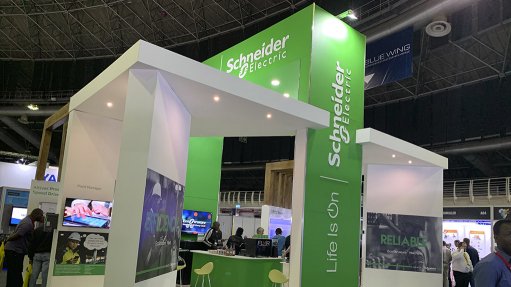
DRIVE FOR FLEXIBLE LOADS The APM drive system provides flexibility for end-users in terms of late changes to the load in the design and installation phase of a project
Automation solutions provider Schneider Electric has added the new Altivar Process Modular (APM) drive system to its range of Altivar Process variable-speed drives (VSDs), which were displayed at the company’s stand at the Africa Automation Fair, held in Johannesburg last month.
“This is a modular drive system that allows for local assembly and reduces the delivery of large drives in a very short time. It also provides flexibility for end-users in terms of late changes to the load in the design and installation phase of a project,” states Schneider Electric VSD product manager Jaque Mare.
It will also reduce the number of critical spares that clients have to keep in stock by about 80% and will improve the “uptime” of an operation. The APM drive system ranges from 110 kW to 1 200 kW.
VSDs in the Altivar Process range assist in optimising business performance across utility and industrial processes that require between 0.75 kW and 1.5 MW.
“VSDs in this range deliver top performance that exceeds expectations. They not only boost efficiency but also improve safety and reliability at your site. They secure what other drives cannot in terms of cybersecurity,” enthuses Mare.
They also have an embedded power-measurement feature with an error rate below 5%, which provides information on consumed energy, compared with that of production.
The Africa Automation Fair provided an ideal platform to show the company’s capabilities, says Schneider Electric industry sales manager Joe von Aulock.
“These capabilities include how we connect our products and edge-devices to collect data in a more meaningful way through applications that are customised to address certain daily challenges that engineers and technicians face,” he points out.
Automated solutions such as this that address client concerns about the future of industrial business centres are important, emphasises Schneider Electric international operations digital transformation leader Quintin McCutcheon.
The company regards these client concerns as reflecting the themes of maintaining operational integrity, managing risk and realising true business value. Focusing on real business value will assist in meeting operational requirements, managing risks from new technologies and preparing plants and machines for the integration of Internet of Things (IoT).
“Introducing clients to cutting-edge solutions, such as cloud technology, for the plant or workshop, product-as-a-service for our architects and increased network optimisation will help them make the best of these new technologies in a secure way and ensure that they are suitable for the industrial environment,” claims McCutcheon.
Integrated Energy Solutions
Schneider Electric’s EcoStruxure offering, a technology architecture and platform which illustrates how companies can maximise benefits gained from digital transformation, particularly in terms of energy and efficiency, was also displayed at the fair.
The EcoStruxure platform can maximise the value of IoT by connecting it to the major technology transformations of mobility, cloud, sensing, analytics and security that are accelerating the merging of operational technology and information technology (IT), McCutcheon illustrates.
“We are in a unique position to increase efficiency and connectivity through combining energy and automation, as well as software- and analytics-integrating IT and operational technology through EcoStruxure. We deliver energy and process efficiency to the markets – buildings, data centres, industry and infrastructure – that comprise 70% of global energy consumption,” claims McCutcheon.
The Schneider Electric Exchange platform, launched in April this year at automation and industrial exhibition Hannover Messe, in Germany, complements these features, as it facilitates collaboration through a cloud-based platform to share insights and designs, as well as manage and complete projects.
The platform provides collaborative tools, access to content, as well as access to experts and business communities.
“The community fosters dialogue with peers and experts to solve technical issues, share knowledge, and connect to reliable partners with skills acknowledged by the community members,” explains McCutcheon.
Further, he highlights the importance of providing solutions for the local market that can be used to mitigate the challenges caused by the lack of energy supply.
He states that convergence of operational technology and IT, use of IoT technologies and the emergence of smart grid technology will encourage the use of energy solutions that are decarbonised, decentralised, digitised and electric.
McCutcheon reiterates that there is an urgent need to change the way the world uses its resources, particularly energy resources. Despite increasing awareness of climate change, the world is becoming more dependent on resources, and digital transformation is vital in addressing this challenge, he claims.
“If we focus on energy, the cumulative energy savings in buildings, as a result of digitisation, could save 65 petawatt (one-billion million Watts) hours by 2040, which is equivalent to the total final energy consumed by countries not aligned to international economic forum the Organisation for Economic Coordination and Development, including China and India, in 2015.”
McCutcheon concludes by maintaining that facilitating digital transformation across buildings, data centres, industry and infrastructure can result in global industry becoming more efficient, reliable, safe and sustainable.